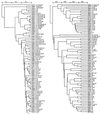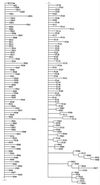Spoligotype diversity of Mycobacterium bovis strains isolated in France from 1979 to 2000
- PMID: 11574583
- PMCID: PMC88399
- DOI: 10.1128/JCM.39.10.3623-3632.2001
Spoligotype diversity of Mycobacterium bovis strains isolated in France from 1979 to 2000
Abstract
The molecular fingerprints of 1,349 isolates of Mycobacterium bovis received between 1979 and August 2000 at Agence Française de Sécurité Sanitaire des Aliments (Afssa) have been obtained by spoligotyping. The majority of the isolates (1,266) were obtained from cattle living in France. An apparently high level of heterogeneity was observed between isolates. One hundred sixty-one spoligotypes were observed in total, of which 153 were from French isolates. The two predominant spoligotypes, designated BCG-like and GB54, accounted for 26 and 12% of the isolates, respectively. In addition, 84% of the spoligotypes were found fewer than 10 times. Analysis of the results by clustering and parsimony-based algorithms revealed that the majority of the spoligotypes were closely related. The predominant spoligotype was identical to that of the vaccine strain Mycobacterium bovis BCG, which was isolated in France at the end of the 19th century. Some spoligotypes were closely associated with restricted geographical areas. Interestingly, some spoligotypes, which were frequently observed in France, were also observed in neighboring countries. Conversely, few spoligotypes were common to France and England, and those that were shared were observed at very different frequencies. This last point illustrates the potential role for an international data bank, which could help trace the spread of M. bovis across national borders.
Figures




References
-
- Alito A, Morcillo N, Scipioni S, Dolmann A, Romano M I, Cataldi A, van Soolingen D. The IS6110 restriction fragment polymorphism in particular multidrug-resistant Mycobacterium tuberculosis strains may evolve too fast for reliable use in outbreak investigation. J Clin Microbiol. 1999;37:788–791. - PMC - PubMed
-
- Anonymous. Direction Générale de l'Alimentation (ed.). Paris, France: Ministère de l'Agriculture et de la Pêche; 2000. Enquête statistique annuelle 1998.
-
- Anonymous. Commission Decision C(2000)-4069 of 11 July 2000 amending the decision 99/467/CE establishing the officially tuberculosis-free status of bovine herds of certain member states or regions of member states. Eur Commun Off J. 2000;L176:51.
-
- Aranaz A, Liebana E, Gomez-Manpaso E, Galan J C, Cousins D, Ortega A, Blasquez J, Baquero F, Mateos A, Suarez G, Dominguez L. Mycobacterium tuberculosis subsp. caprae subsp. nov.: a taxonomic study of a new member of the Mycobacterium tuberculosis complex isolated from goats in Spain. Int J Syst Bacteriol. 1999;49:1263–1273. - PubMed
-
- Aranaz A, Liebana E, Mateos A, Dominguez L, Cousins D. Restriction Fragment Length Polymorphism and spacer oligonucleotide typing: a comparative analysis of fingerprinting strategies for Mycobacterium bovis. Vet Microbiol. 1998;61:311–324. - PubMed
MeSH terms
Substances
LinkOut - more resources
Full Text Sources
Molecular Biology Databases

